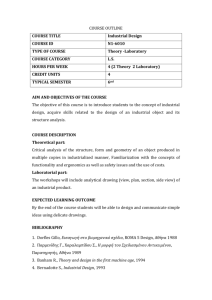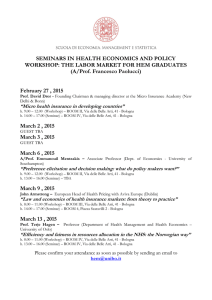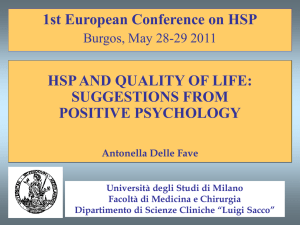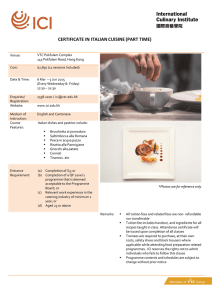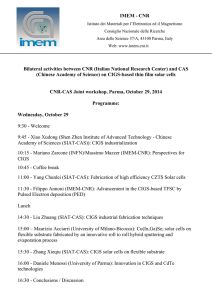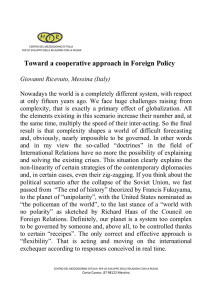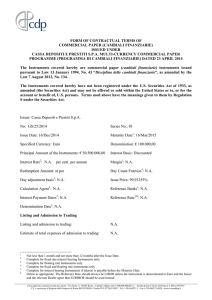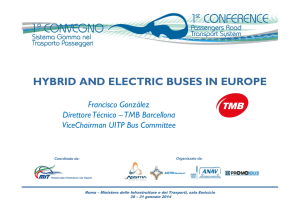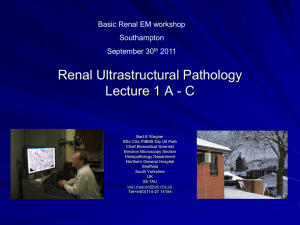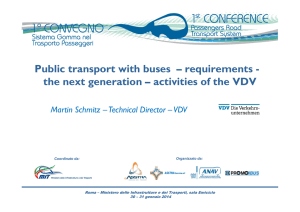Dalla psicoanalisi delle nevrosi alla psicosomatica delle demenze
advertisement
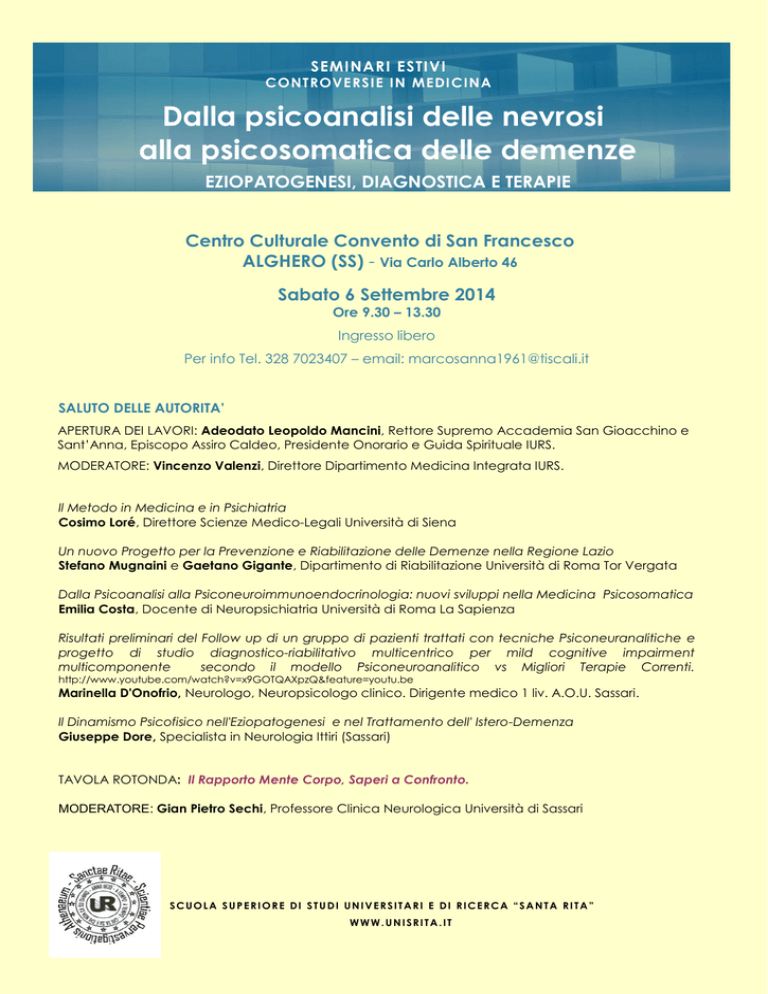
SEMINARI ESTIVI CONTROVERSIE IN MEDI CINA Dalla psicoanalisi delle nevrosi alla psicosomatica delle demenze EZIOPATOGENESI, DIAGNOSTICA E TERAPIE Centro Culturale Convento di San Francesco ALGHERO (SS) - Via Carlo Alberto 46 Sabato 6 Settembre 2014 Ore 9.30 – 13.30 Ingresso libero Per info Tel. 328 7023407 – email: marcosanna1961@tiscali.it SALUTO DELLE AUTORITA’ APERTURA DEI LAVORI: Adeodato Leopoldo Mancini, Rettore Supremo Accademia San Gioacchino e Sant’Anna, Episcopo Assiro Caldeo, Presidente Onorario e Guida Spirituale IURS. MODERATORE: Vincenzo Valenzi, Direttore Dipartimento Medicina Integrata IURS. Il Metodo in Medicina e in Psichiatria Cosimo Loré, Direttore Scienze Medico-Legali Università di Siena Un nuovo Progetto per la Prevenzione e Riabilitazione delle Demenze nella Regione Lazio Stefano Mugnaini e Gaetano Gigante, Dipartimento di Riabilitazione Università di Roma Tor Vergata Dalla Psicoanalisi alla Psiconeuroimmunoendocrinologia: nuovi sviluppi nella Medicina Psicosomatica Emilia Costa, Docente di Neuropsichiatria Università di Roma La Sapienza Risultati preliminari del Follow up di un gruppo di pazienti trattati con tecniche Psiconeuranalitiche e progetto di studio diagnostico-riabilitativo multicentrico per mild cognitive impairment multicomponente secondo il modello Psiconeuroanalitico vs Migliori Terapie Correnti. http://www.youtube.com/watch?v=x9GOTQAXpzQ&feature=youtu.be Marinella D'Onofrio, Neurologo, Neuropsicologo clinico. Dirigente medico 1 liv. A.O.U. Sassari. Il Dinamismo Psicofisico nell'Eziopatogenesi e nel Trattamento dell' Istero-Demenza Giuseppe Dore, Specialista in Neurologia Ittiri (Sassari) TAVOLA ROTONDA: Il Rapporto Mente Corpo, Saperi a Confronto. MODERATORE: Gian Pietro Sechi, Professore Clinica Neurologica Università di Sassari SCUOLA SUPERIORE DI STUDI UNIVERSITARI E DI RICERCA “SANTA RI TA” WWW.UNISRITA.IT PAGINA 2 DALLA PSICOANALISI DELLE NEVROSI ALLA PSICOSOMATICA DELLE DEMENZE MATERIALI DA FENS, MATHESIS ECC. Lettera aperta ai colleghi riuniti a Milano al Congresso europeo di Neuroscienze http://lestreghedellaluna.forumfree.it/?t=69122798#lastpost Il congresso europeo di Kiev http://vglobale.it/attualita/16603-a-kiev-la-scienza-oltre-lecontese-politiche.html ALCUNI CONTRIBUTI DI GRANDE INTERESSE DAL CONGRESSO DI MILANO http://fens2014.neurosciences.asso.fr/index.php Multiple mechanisms of neurodegeneration and progression Disease modification in Alzheimer’s disease: how far are we? Silvia A. Mandel Research Director, Discovery & Product Development. Teva Pharmaceuticals, Israel V ast efforts have been put in the past years by the pharmaceutical companies in developing disease-modifying therapeutic approaches for Alzheimer’s disease (AD), centering to a large extent on the amyloid cascade hypothesis. Disappointingly, the amyloid peptide immunotherapy directed trials in AD failed to meet clinical endpoints. This may be explained in part by the advanced stage of the disease at time of treatment to potentially reverse or slow symptoms. Also, the poor antibody design and brain penetrance together with the preclinical data may have misled the clinical translation validity of the treatments. There is still the matter of relevance of the amyloid plaques vs soluble Aβ oligomers in AD pathogenesis. Brain amyloidosis and fibrillated Tau are downstream disease markers and not disease initiators. It is now well established that the pathology of AD is not the gold standard. It does not correlate with the severity of dementia. Plaques and tangles are present also in cognitively healthy individuals. AD is a multi-etiological disease entity, individuals accumulate pathologies throughout life. Initiation of AD pathology is estimated to begin ~10-15 years prior to the onset of clinical symptoms, and thus there is a long phase that precedes the classical symptomatology (prodromal AD). Individuals at early stages of AD are the most likely to benefit from disease-modifying therapies should they become available. The challenge is to find the meaningful biological targets for new diagnostic and drug development. In my talk I will elaborate on emerging targets and strategies in AD and the perspectives for new therapeutics. DALLA PSICOANALISI DELLE NEVROSI ALLA PSICOSOMATICA DELLE DEMENZE PAGINA 3 Tau-protein potentizes the toxic effect of beta-amyloid Bobkova, Nv.1, Tatarnikova, Og.1,3, Kleniaeva, An.1,2, Orlov, Ma.1,3 and Panchenko, Mm.1 1. Federal State Institution of Science Institute of Cell Biophysics Russian Academy of Sciences, Pushchino, Russia 2. Federal State Educational Institution of Higher Professional Education "Moscow Institute of Physics and Technology", Dolgoprudny, Russia 3. Moscow State University named M.V.Lomonosov, Moscow, Russia T he idea about the interaction between Аβ and Tau protein toxic effects for a long time was not finding support. Study of the functional role of these proteins separated researchers at two “camps” in accordance with the accepted hypothesis of the pathogenesis of Alzheimer's disease (AD) - “amyloid cascade hypothesis”, insisting on a key role of Аβ [Selkoe, 2002], and "tau-hypothesis”, giving priority to Tau protein [Trojanowski and Lee, 2002]. Here we check the character of this interaction. Previously we developed in vitro cell model of process of formation of the fibrillar Tauprotein forms by line of cell 3T3-4R-Tau, constantly expressing human Tau-protein (4Rform). Test system was primary culture from the hippocampus of newborn rats. Cells in culture were stained with Hoechst 33342 which is cell-permeable and able to bind to DNA (excitation - 350 nm) or with propidium iodide which is permeable for dead cells (excitation - 536 nm). Co-cultivation 3T3-4R-Tau cells with primary culture of the hippocampus showed an increase number of dead cells. The preincubation of 3T3-4R-Tau cells with Аβ (1-42) and following co-cultivation 3T3-4R-Tau cells with primary culture increased their toxicity and induces massive extinction of the hippocampal cells. Thus, we have established toxic effect of Aβ is mediated through protein Tau, that allows for new insights into the pathogenesis of AD. This work was supported by the Program Presidium Russian Aqcademy of Science "Fundamental research to develop biomedical technologies" 2014. N eurodegenerative disorders are relentless progressive diseases and produce care- dependency as well as important health-related public comsumption. So far, we don’t know the cause of these disorders and then there are not successful treatments available and some of the drugs use don symptomatic treatments, over time universally become ineffective. Thus, the need to develop more effective treatments for the neurodegenerative disorders is widely recognized, however, as we don’t still know the ultimate cause it is difficult to. Moroever, as the degeneration progresses, patients become more and more dependent of the family as well as of the social security, and the truth is that for these diseases there is currently no cure. PAGINA 4 DALLA PSICOANALISI DELLE NEVROSI ALLA PSICOSOMATICA DELLE DEMENZE The pathogenesis of different neurodegenerative diseases, such as Alzheimer’s (AD) and Parkinson’s (PD) shares several common features. One of these is the abnormal accumulation and aggregation of disease-specific proteins, which is suggested to lead to neurodegeneration. Recent evidence also indicates that the aggregated proteins may spread from one cell or brain area to another and function as seeds to instigate protein misfolding and aggregation in these previously unaffected cells or areas. Genetic mutations or different environmental factors, such as oxidative or metabolic stress, have been suggested to promote protein mis-folding and aggregation in different neurodegenerative diseases. In fact, the combination of genetic mutations and enviromental factors can induce protein misfolding and aggregation; however, the exact underlying mechanisms of protein aggregation in different neurodegenerative disorders are still not completely understood. The degeneration factors together with physiological aging and other factors involved in the pathogenic mechanisms underlying these neurodegenerative disorders (such as inflammation and oxidative or metabolic stress and pathogenic disease-associated mutations) could play an important role in determining the onset and progression of the disease and finally causing widespread neuro degeneration in specific brain regions. Then, this sattelite event looks for discuss the multiple mechanisms of neurodegeneration in different diseases as well as to analyze the posible causes of the cell death progression. This may provide novel opportunities to better understand the disease pathogenesis and subsequently to identify new disease biomarkers and therapeutic targets for an earlier diagnosis and treatment of patients suffering from different neurodegenerative disorders. The speakers will be able to discuss offering their expertise in several fields of neurodegeneration and all together can explain to each other some causes of the gradual progression of the disease pathology in the brain over time (at least in the case of the most prevalent neurodegenerative disorders).
